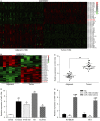MiR-130b promotes the progression of oesophageal squamous cell carcinoma by targeting SASH1
- PMID: 30443973
- PMCID: PMC6307769
- DOI: 10.1111/jcmm.13887
MiR-130b promotes the progression of oesophageal squamous cell carcinoma by targeting SASH1
Abstract
MiR-130b and SAM and SH3 domain containing 1 (SASH1) play an important role in many types of human cancers. The aim of our research was to study their interactions in the process of the proliferation and aggressiveness of oesophageal squamous cell carcinoma (ESCC) cells. Microarray analysis was done to screen the differentially expressed genes in the ESCC tissues. miR-130b and SASH1 mRNA levels in the ESCC tissues and cells were detected by qRT-PCR. Dual luciferase reporter system was used to verify the target relationship between miR-130b and SASH1. The effects of miR-130b on SASH1 expression were explored by western blot in KYSE30 and TE1 cell lines. CCK-8 assay, flow cytometry, Transwell, and wound healing assays were conducted to explore the effects of miR-130b and SASH1 in vitro. In addition, in vivo experiments were conducted to study the roles of miR-130b and SASH1. miR-130b was highly expressed, while SASH1 was the opposite in both the ESCC tissues and cells. The expression of SASH1 was inhibited by the direct binding of miR-130b. The inhibition of miR-130b reduced the proliferation and aggressiveness of ESCC cells, while it also induced apoptosis and cell cycle arrest in the ESCC cells by suppressing SASH1. The in vivo assay suggested that the overexpression of miR-130b promoted the growth of ESCC tumours. MiR-130b was up-regulated in the ESCC tumour tissues and cells, acting as a tumour promoter. A stimulating effect was demonstrated on ESCC cell growth and aggressiveness by suppressing SASH1, which is an anti-oncogene.
Keywords: SASH1; MiR-130b; esophageal squamous cell carcinoma.
© 2018 The Authors. Journal of Cellular and Molecular Medicine published by John Wiley & Sons Ltd and Foundation for Cellular and Molecular Medicine.
Figures







Similar articles
-
MiR-130b plays an oncogenic role by repressing PTEN expression in esophageal squamous cell carcinoma cells.BMC Cancer. 2015 Jan 31;15:29. doi: 10.1186/s12885-015-1031-5. BMC Cancer. 2015. PMID: 25637514 Free PMC article.
-
Downregulation of MiR-31 stimulates expression of LATS2 via the hippo pathway and promotes epithelial-mesenchymal transition in esophageal squamous cell carcinoma.J Exp Clin Cancer Res. 2017 Nov 16;36(1):161. doi: 10.1186/s13046-017-0622-1. J Exp Clin Cancer Res. 2017. PMID: 29145896 Free PMC article.
-
miR-133a-3p suppresses cell proliferation, migration, and invasion and promotes apoptosis in esophageal squamous cell carcinoma.J Cell Physiol. 2019 Aug;234(8):12757-12770. doi: 10.1002/jcp.27896. Epub 2018 Dec 10. J Cell Physiol. 2019. PMID: 30537034
-
The emerging and diverse roles of the SLy/SASH1-protein family in health and disease-Overview of three multifunctional proteins.FASEB J. 2021 Apr;35(4):e21470. doi: 10.1096/fj.202002495R. FASEB J. 2021. PMID: 33710696 Review.
-
The Structural Dynamics, Complexity of Interactions, and Functions in Cancer of Multi-SAM Containing Proteins.Cancers (Basel). 2023 Jun 1;15(11):3019. doi: 10.3390/cancers15113019. Cancers (Basel). 2023. PMID: 37296980 Free PMC article. Review.
Cited by
-
Role of MicroRNAs in Host Defense against Infectious Bursal Disease Virus (IBDV) Infection: A Hidden Front Line.Viruses. 2020 May 14;12(5):543. doi: 10.3390/v12050543. Viruses. 2020. PMID: 32423052 Free PMC article. Review.
-
SASH1 Suppresses the Proliferation and Invasion of Human Skin Squamous Cell Carcinoma Cells via Inhibiting Akt Cascade.Onco Targets Ther. 2020 May 25;13:4617-4625. doi: 10.2147/OTT.S234667. eCollection 2020. Onco Targets Ther. 2020. PMID: 32547092 Free PMC article.
-
Uncovering a new SASH1 mutation associated with dyschromatosis universalis hereditaria using whole-exome-sequencing: A case report.Medicine (Baltimore). 2023 Aug 4;102(31):e34448. doi: 10.1097/MD.0000000000034448. Medicine (Baltimore). 2023. PMID: 37543808 Free PMC article.
-
STAT3/miR-130b-3p/MBNL1 feedback loop regulated by mTORC1 signaling promotes angiogenesis and tumor growth.J Exp Clin Cancer Res. 2022 Oct 11;41(1):297. doi: 10.1186/s13046-022-02513-z. J Exp Clin Cancer Res. 2022. PMID: 36217202 Free PMC article.
-
Silencing of methyltransferase-like 3 inhibits oesophageal squamous cell carcinoma.Exp Ther Med. 2020 Dec;20(6):138. doi: 10.3892/etm.2020.9267. Epub 2020 Oct 2. Exp Ther Med. 2020. PMID: 33082869 Free PMC article.
References
-
- Enzinger PC, Mayer RJ. Esophageal cancer. N Engl J Med. 2003;349:2241‐2252. - PubMed
-
- Matsushima K, Isomoto H, Kohno S, et al. MicroRNAs and esophageal squamous cell carcinoma. Digestion. 2010;82:138‐144. - PubMed
-
- Luthra R, Wu TT, Luthra MG, et al. Gene expression profiling of localized esophageal carcinomas: association with pathologic response to preoperative chemoradiation. J Clin Oncol. 2006;24:259‐267. - PubMed
Publication types
MeSH terms
Substances
LinkOut - more resources
Full Text Sources
Medical

